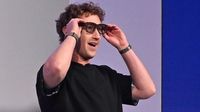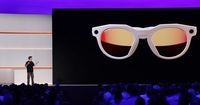On September 18, 2025, the tech world turned its eyes to Menlo Park, California, as Meta CEO Mark Zuckerberg took the stage at the company’s annual Connect event. There, he introduced what he called “the next evolution in AI glasses”—the Meta Ray-Ban Display and its companion, the Meta Neural Band. These new devices, blending artificial intelligence, wearable technology, and classic eyewear design, signal Meta’s ambitious push to redefine how we interact with technology in our daily lives.
“Glasses are the ideal form factor for personal super intelligence because they let you stay present in the moment while getting access to all of these AI capabilities to make you smarter, help you communicate better, improve your memory, improve your senses,” Zuckerberg declared at the event, according to CNN. The statement captured the ethos behind Meta’s latest offering: a desire to keep users engaged with the world around them, rather than glued to their phone screens.
The Meta Ray-Ban Display glasses, developed in partnership with eyewear giant EssilorLuxottica, look much like ordinary prescription lenses or sunglasses. But inside the right lens lies a tiny, high-resolution, full-color display, positioned off to the side so it doesn’t obstruct the user’s view. The display springs to life for brief, controlled interactions—checking messages, previewing photos, translating conversations, or getting help from Meta AI—then fades away, letting the wearer stay present in their environment. As Zuckerberg explained, “When we’re designing the hardware and software, we focus on giving you access to very powerful tools when you want them, and then just having them fade into the background when you’re not.”
Meta’s vision for these glasses is clear: to put AI technology at users’ fingertips (or, more accurately, at their temples), making it a seamless part of everyday life. The glasses allow users to view and send messages, capture and review photos and videos, watch Instagram Reels, and even take live video calls—where they can see the person on the other end, right in their lens. A navigation feature projects real-time walking directions and maps, while live captioning and translation display spoken words as text in real time, breaking down language barriers and making conversations more accessible. All of this information is private—only the wearer can see the display, and it can be switched off at any time, transforming the glasses back into classic eyewear.
But the real magic, as Zuckerberg and his team emphasized, comes with the Meta Neural Band. This EMG (electromyography) wristband translates muscle signals from subtle hand and finger movements into digital commands for the glasses. Instead of fumbling with touchscreens or physical buttons, users can scroll, click, and—even in the near future—write out messages using gestures as simple as tapping their thumb and index finger. The technology is the result of years of research and nearly 200,000 participants, allowing the band to work for almost anyone, regardless of muscle differences or hand shape.
The wristband’s accessibility potential is significant. According to Meta, muscle signals at the wrist can provide control signals for people unable to make large movements due to spinal cord injuries, strokes, or other disabilities. The band is designed to be worn all day, offering up to 18 hours of battery life, an IPX7 water rating, and is crafted with Vectran—the same material used on the Mars Rover’s crash pads—making it both durable and comfortable. It comes in three sizes for a custom fit.
Meta Ray-Ban Display and the Neural Band will be available starting September 30, 2025, at select US retailers including Best Buy, LensCrafters, Sunglass Hut, Ray-Ban Stores, and soon at Verizon stores, with a starting price of $799. International expansion to Canada, France, Italy, and the UK is set for early 2026. The glasses are available in Black and Sand colors, feature Transitions® lenses for both indoor and outdoor use, and offer up to six hours of mixed-use battery life, extendable to 30 hours with the portable charging case.
These new devices are part of a broader strategy. Meta now categorizes its AI glasses into three distinct types: Camera AI glasses (like the Ray-Ban Meta Gen 2 and the new Meta Oakley Vanguard), Display AI glasses (the new Meta Ray-Ban Display), and Augmented Reality glasses (such as the Orion prototype, which is still under development). The Ray-Ban Meta Gen 2, priced at $379, boasts improved battery life, higher-quality 3K video, and will soon support slow-motion and hyperlapse videos. The Meta Oakley Vanguard, designed for sports and outdoor activities, integrates with platforms like Strava and Garmin, and features enhanced audio and camera capabilities for active users.
As reported by CNN, EssilorLuxottica’s Chief Wearables Officer Rocco Basilico called the new display glasses “the biggest launch that we have done so far.” He emphasized that users can “wear the glasses and feel good in your favorite brands, but if you actually need, like, some super-powers, some immediate information, that could be delivered through audio or through the display.”
Despite the excitement, the technology isn’t without its growing pains. Live demos at the Connect event revealed a few hiccups—Meta’s AI assistant failed to respond intelligibly during a cooking demonstration, and a video call acceptance button didn’t appear during a test. Zuckerberg and Chief Technology Officer Andrew Bosworth shrugged off these glitches, with Bosworth quipping, “We’ll debug that later.” These moments, while imperfect, highlighted that the field of smart glasses is still in its early stages, with plenty of room for growth and refinement.
Meta is not alone in this space. The company faces stiff competition from tech heavyweights like Google, Samsung, Snap, and Amazon, all racing to develop the most advanced and widely adopted smart glasses. Still, Meta’s commitment is clear: according to EssilorLuxottica, the company aims to produce 10 million pairs of Meta glasses annually starting in 2026. Revenue from Meta glasses more than tripled year-over-year, a sign that consumer adoption—while still niche—is accelerating.
The potential applications for these devices are vast. Pedestrian navigation, hands-free messaging, real-time translation, and even music playback (with gesture-based controls) are just the beginning. For professionals, features like live captioning with transcripts saved in the Meta AI app could transform meetings and interviews. For people with disabilities, the EMG-based Neural Band offers new avenues for digital interaction and independence. And for everyone, the promise is simple: technology that keeps you connected, informed, and present—without pulling you out of the moment.
As Zuckerberg put it, “We have been working on glasses for more than 10 years, and this is one of those special moments where we get to show you something that we poured a lot of our lives into, and that I just think is different from anything that I’ve seen.” With the Meta Ray-Ban Display and Neural Band, Meta is betting big on a future where the boundary between the digital and physical worlds is thinner than ever—and where technology, for once, might just let us look up and see what’s right in front of us.






